Competitive Strategies: HI6006 Key Strategy Development Tools
VerifiedAdded on 2023/02/01
|8
|1813
|71
Essay
AI Summary
This essay delves into the realm of competitive strategies, examining four key models: cost leadership, cost focus, focus differentiation, and leadership differentiation. It provides a comprehensive overview of each strategy, outlining their core principles and practical applications. The essay uses real-world business examples, such as Wal-Mart and Nike, to illustrate how these strategies are implemented and how they contribute to a firm's competitive advantage. It highlights the importance of understanding these strategies for businesses to cope with market forces. The analysis emphasizes the significance of cost control and differentiation as primary drivers of competitive advantage. The essay concludes by underscoring the need for businesses to progressively seek ways to maintain a competitive edge. This essay is a detailed analysis of strategic models and their applications in the business world, focusing on the crucial role of competitive strategies.
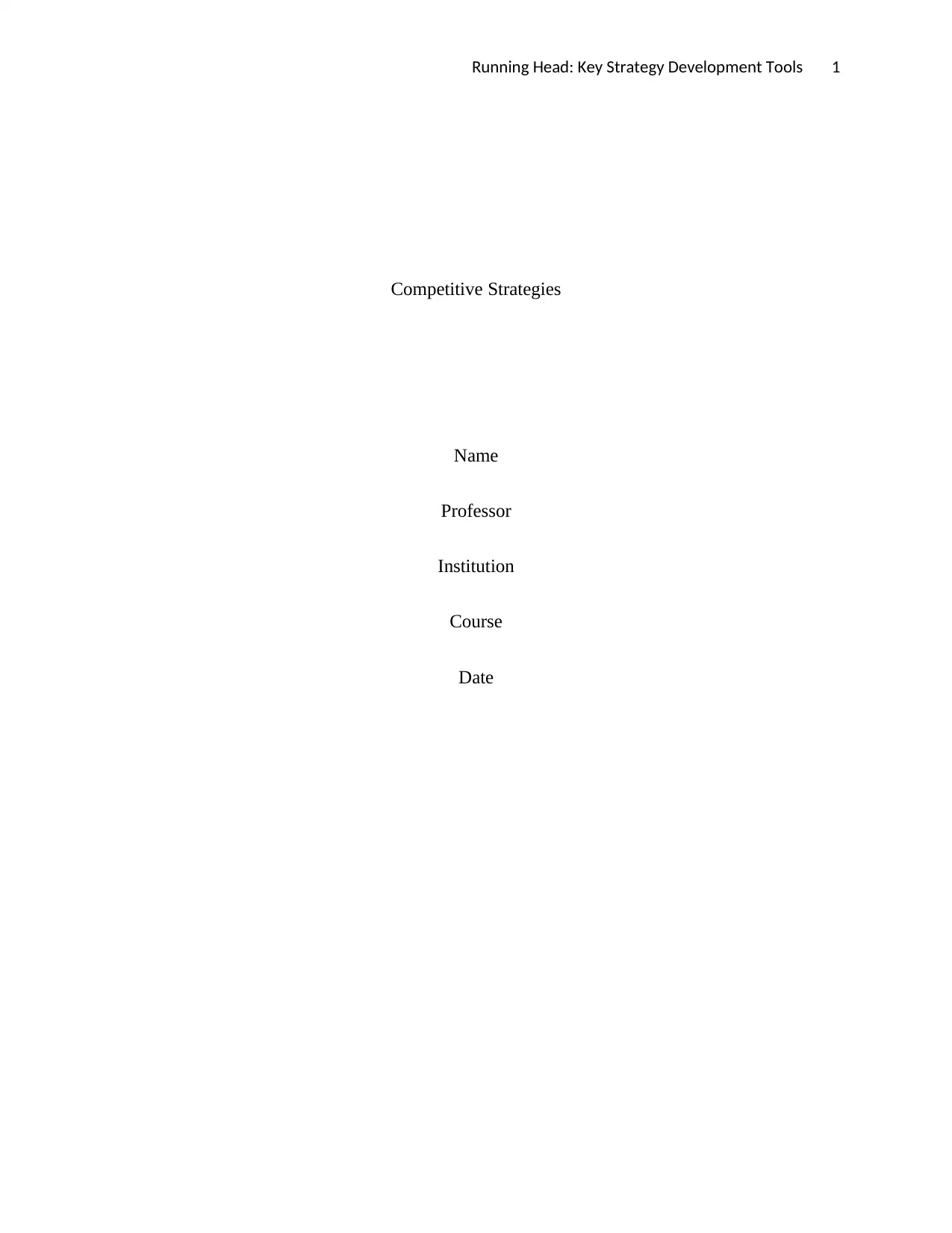
Running Head: Key Strategy Development Tools 1
Competitive Strategies
Name
Professor
Institution
Course
Date
Competitive Strategies
Name
Professor
Institution
Course
Date
Paraphrase This Document
Need a fresh take? Get an instant paraphrase of this document with our AI Paraphraser

Key Strategy Development Tools 2
Introduction
The competitive advantage of any business is adopted through four generic strategies,
which allows the scope of business to differentiate products. However, the only key to strategic
challenge for many businesses is by finding a way of achieving a suitable competitive advantage,
with other firms. Porter introduced four competitive strategies; cost leadership, focus, leadership
differentiation as well as focus differentiation of a complete definition of competitive advantage
based advantages Magretta,2012 112). Thus, the strategies involve taking invasive practices,
with the aim of generating a defendable position in the firm. However, the strategies are crucial
since they aid businesses in coping with competitive forces they face, to do better than other
organizations. Literally, the firm only pursues one of the four strategies, although business makes
an effort of pursuing more than one approach. Nonetheless, Cost control and variation strategies
are primary ways that a firm would likely incur a competitive advantage.
Cost Leadership
The basic strategy of cost leadership is based on the lowest cost producer in the industry
since it is crucial in the market segments with the emphasis of minimal cost. However, cost
leadership is mainly associated with large-scale organizations that offer products with little
differentiation readily acceptable in the market. Occasionally, business under low-cost strategy
would likely set discounts on products and sales to ensure it generates a significant cost
advantage over competition (Reitsperger, Daniel, Tallman & Chismar, 2013 15). The strategy
main focus is based on efficiency, whereby business produces high volumes of standardized
products. Thus, the business’ hope of taking advantage of economic scales and experience curve
effects is satisfied. According to Porter, a business aiming to succeed through the low- cost
strategy should ensure that it shares preferential access to raw materials as well as components
Introduction
The competitive advantage of any business is adopted through four generic strategies,
which allows the scope of business to differentiate products. However, the only key to strategic
challenge for many businesses is by finding a way of achieving a suitable competitive advantage,
with other firms. Porter introduced four competitive strategies; cost leadership, focus, leadership
differentiation as well as focus differentiation of a complete definition of competitive advantage
based advantages Magretta,2012 112). Thus, the strategies involve taking invasive practices,
with the aim of generating a defendable position in the firm. However, the strategies are crucial
since they aid businesses in coping with competitive forces they face, to do better than other
organizations. Literally, the firm only pursues one of the four strategies, although business makes
an effort of pursuing more than one approach. Nonetheless, Cost control and variation strategies
are primary ways that a firm would likely incur a competitive advantage.
Cost Leadership
The basic strategy of cost leadership is based on the lowest cost producer in the industry
since it is crucial in the market segments with the emphasis of minimal cost. However, cost
leadership is mainly associated with large-scale organizations that offer products with little
differentiation readily acceptable in the market. Occasionally, business under low-cost strategy
would likely set discounts on products and sales to ensure it generates a significant cost
advantage over competition (Reitsperger, Daniel, Tallman & Chismar, 2013 15). The strategy
main focus is based on efficiency, whereby business produces high volumes of standardized
products. Thus, the business’ hope of taking advantage of economic scales and experience curve
effects is satisfied. According to Porter, a business aiming to succeed through the low- cost
strategy should ensure that it shares preferential access to raw materials as well as components
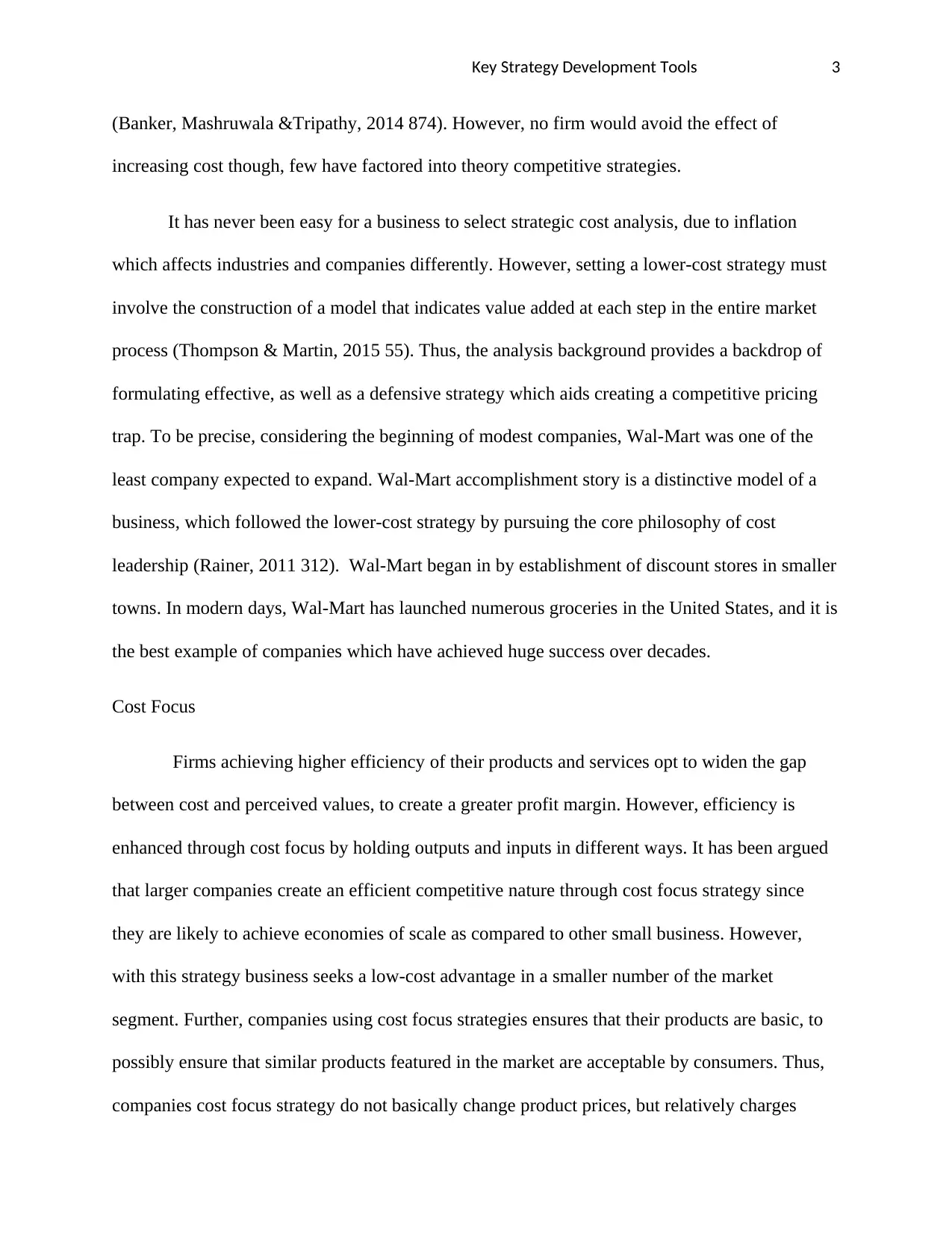
Key Strategy Development Tools 3
(Banker, Mashruwala &Tripathy, 2014 874). However, no firm would avoid the effect of
increasing cost though, few have factored into theory competitive strategies.
It has never been easy for a business to select strategic cost analysis, due to inflation
which affects industries and companies differently. However, setting a lower-cost strategy must
involve the construction of a model that indicates value added at each step in the entire market
process (Thompson & Martin, 2015 55). Thus, the analysis background provides a backdrop of
formulating effective, as well as a defensive strategy which aids creating a competitive pricing
trap. To be precise, considering the beginning of modest companies, Wal-Mart was one of the
least company expected to expand. Wal-Mart accomplishment story is a distinctive model of a
business, which followed the lower-cost strategy by pursuing the core philosophy of cost
leadership (Rainer, 2011 312). Wal-Mart began in by establishment of discount stores in smaller
towns. In modern days, Wal-Mart has launched numerous groceries in the United States, and it is
the best example of companies which have achieved huge success over decades.
Cost Focus
Firms achieving higher efficiency of their products and services opt to widen the gap
between cost and perceived values, to create a greater profit margin. However, efficiency is
enhanced through cost focus by holding outputs and inputs in different ways. It has been argued
that larger companies create an efficient competitive nature through cost focus strategy since
they are likely to achieve economies of scale as compared to other small business. However,
with this strategy business seeks a low-cost advantage in a smaller number of the market
segment. Further, companies using cost focus strategies ensures that their products are basic, to
possibly ensure that similar products featured in the market are acceptable by consumers. Thus,
companies cost focus strategy do not basically change product prices, but relatively charges
(Banker, Mashruwala &Tripathy, 2014 874). However, no firm would avoid the effect of
increasing cost though, few have factored into theory competitive strategies.
It has never been easy for a business to select strategic cost analysis, due to inflation
which affects industries and companies differently. However, setting a lower-cost strategy must
involve the construction of a model that indicates value added at each step in the entire market
process (Thompson & Martin, 2015 55). Thus, the analysis background provides a backdrop of
formulating effective, as well as a defensive strategy which aids creating a competitive pricing
trap. To be precise, considering the beginning of modest companies, Wal-Mart was one of the
least company expected to expand. Wal-Mart accomplishment story is a distinctive model of a
business, which followed the lower-cost strategy by pursuing the core philosophy of cost
leadership (Rainer, 2011 312). Wal-Mart began in by establishment of discount stores in smaller
towns. In modern days, Wal-Mart has launched numerous groceries in the United States, and it is
the best example of companies which have achieved huge success over decades.
Cost Focus
Firms achieving higher efficiency of their products and services opt to widen the gap
between cost and perceived values, to create a greater profit margin. However, efficiency is
enhanced through cost focus by holding outputs and inputs in different ways. It has been argued
that larger companies create an efficient competitive nature through cost focus strategy since
they are likely to achieve economies of scale as compared to other small business. However,
with this strategy business seeks a low-cost advantage in a smaller number of the market
segment. Further, companies using cost focus strategies ensures that their products are basic, to
possibly ensure that similar products featured in the market are acceptable by consumers. Thus,
companies cost focus strategy do not basically change product prices, but relatively charges
⊘ This is a preview!⊘
Do you want full access?
Subscribe today to unlock all pages.

Trusted by 1+ million students worldwide
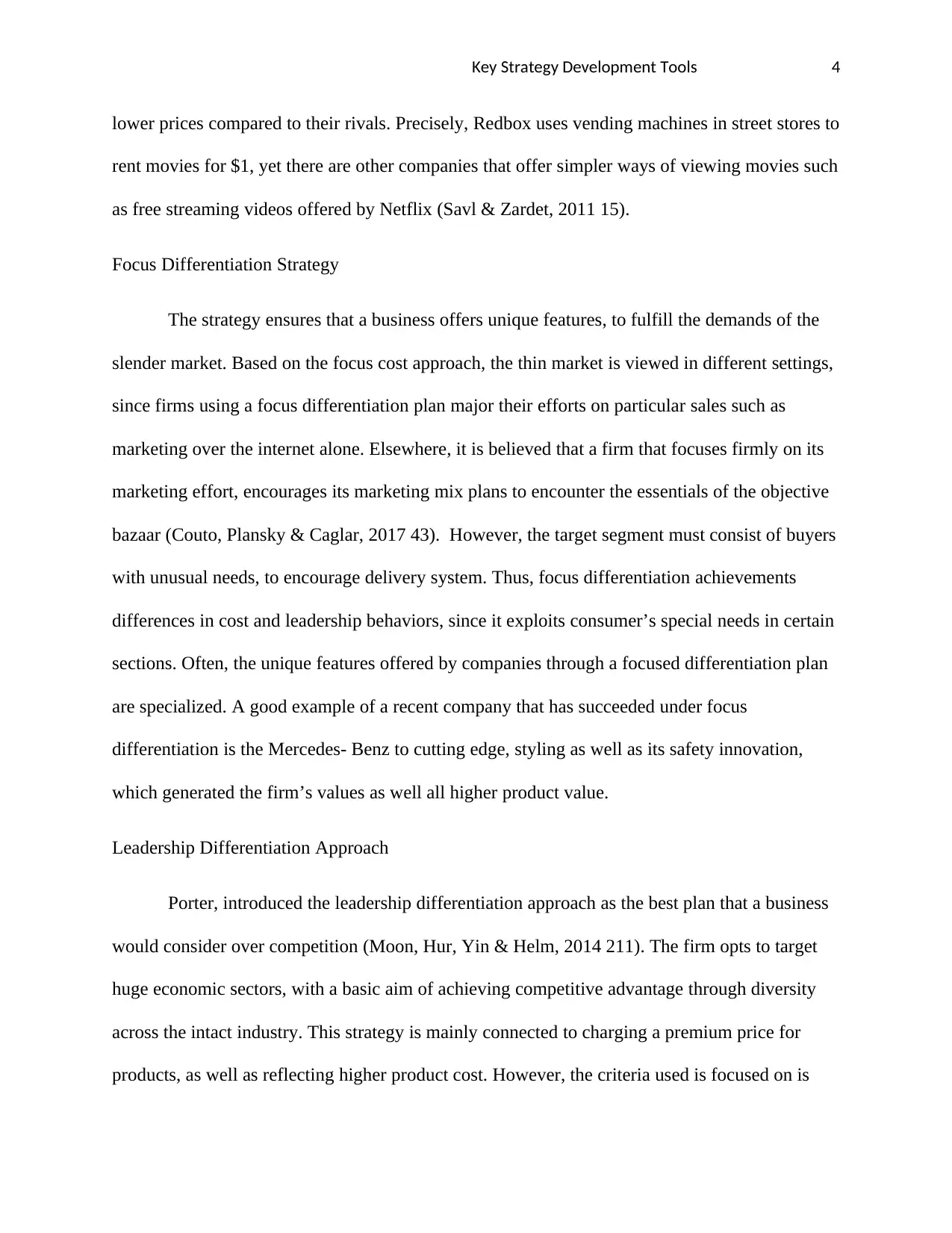
Key Strategy Development Tools 4
lower prices compared to their rivals. Precisely, Redbox uses vending machines in street stores to
rent movies for $1, yet there are other companies that offer simpler ways of viewing movies such
as free streaming videos offered by Netflix (Savl & Zardet, 2011 15).
Focus Differentiation Strategy
The strategy ensures that a business offers unique features, to fulfill the demands of the
slender market. Based on the focus cost approach, the thin market is viewed in different settings,
since firms using a focus differentiation plan major their efforts on particular sales such as
marketing over the internet alone. Elsewhere, it is believed that a firm that focuses firmly on its
marketing effort, encourages its marketing mix plans to encounter the essentials of the objective
bazaar (Couto, Plansky & Caglar, 2017 43). However, the target segment must consist of buyers
with unusual needs, to encourage delivery system. Thus, focus differentiation achievements
differences in cost and leadership behaviors, since it exploits consumer’s special needs in certain
sections. Often, the unique features offered by companies through a focused differentiation plan
are specialized. A good example of a recent company that has succeeded under focus
differentiation is the Mercedes- Benz to cutting edge, styling as well as its safety innovation,
which generated the firm’s values as well all higher product value.
Leadership Differentiation Approach
Porter, introduced the leadership differentiation approach as the best plan that a business
would consider over competition (Moon, Hur, Yin & Helm, 2014 211). The firm opts to target
huge economic sectors, with a basic aim of achieving competitive advantage through diversity
across the intact industry. This strategy is mainly connected to charging a premium price for
products, as well as reflecting higher product cost. However, the criteria used is focused on is
lower prices compared to their rivals. Precisely, Redbox uses vending machines in street stores to
rent movies for $1, yet there are other companies that offer simpler ways of viewing movies such
as free streaming videos offered by Netflix (Savl & Zardet, 2011 15).
Focus Differentiation Strategy
The strategy ensures that a business offers unique features, to fulfill the demands of the
slender market. Based on the focus cost approach, the thin market is viewed in different settings,
since firms using a focus differentiation plan major their efforts on particular sales such as
marketing over the internet alone. Elsewhere, it is believed that a firm that focuses firmly on its
marketing effort, encourages its marketing mix plans to encounter the essentials of the objective
bazaar (Couto, Plansky & Caglar, 2017 43). However, the target segment must consist of buyers
with unusual needs, to encourage delivery system. Thus, focus differentiation achievements
differences in cost and leadership behaviors, since it exploits consumer’s special needs in certain
sections. Often, the unique features offered by companies through a focused differentiation plan
are specialized. A good example of a recent company that has succeeded under focus
differentiation is the Mercedes- Benz to cutting edge, styling as well as its safety innovation,
which generated the firm’s values as well all higher product value.
Leadership Differentiation Approach
Porter, introduced the leadership differentiation approach as the best plan that a business
would consider over competition (Moon, Hur, Yin & Helm, 2014 211). The firm opts to target
huge economic sectors, with a basic aim of achieving competitive advantage through diversity
across the intact industry. This strategy is mainly connected to charging a premium price for
products, as well as reflecting higher product cost. However, the criteria used is focused on is
Paraphrase This Document
Need a fresh take? Get an instant paraphrase of this document with our AI Paraphraser
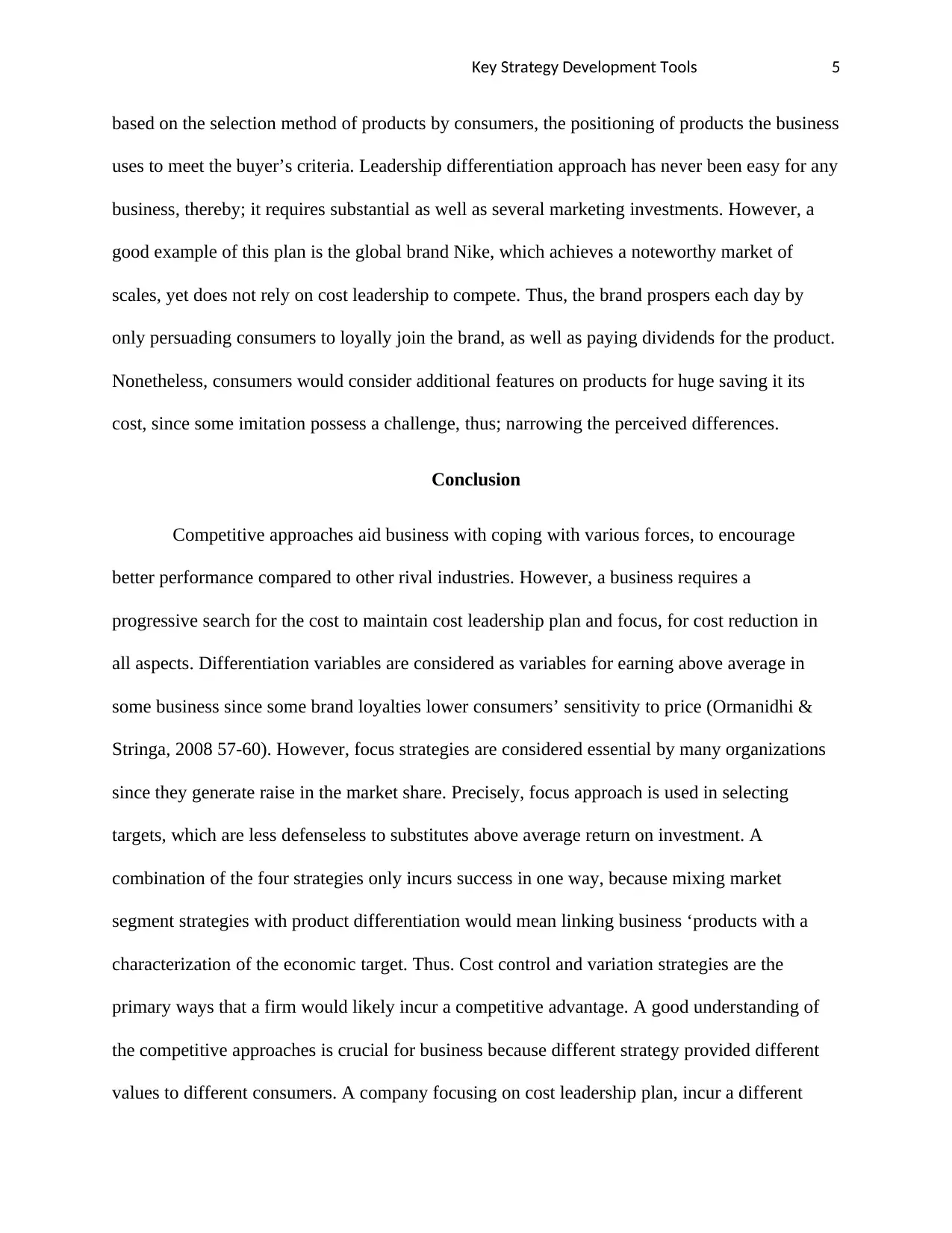
Key Strategy Development Tools 5
based on the selection method of products by consumers, the positioning of products the business
uses to meet the buyer’s criteria. Leadership differentiation approach has never been easy for any
business, thereby; it requires substantial as well as several marketing investments. However, a
good example of this plan is the global brand Nike, which achieves a noteworthy market of
scales, yet does not rely on cost leadership to compete. Thus, the brand prospers each day by
only persuading consumers to loyally join the brand, as well as paying dividends for the product.
Nonetheless, consumers would consider additional features on products for huge saving it its
cost, since some imitation possess a challenge, thus; narrowing the perceived differences.
Conclusion
Competitive approaches aid business with coping with various forces, to encourage
better performance compared to other rival industries. However, a business requires a
progressive search for the cost to maintain cost leadership plan and focus, for cost reduction in
all aspects. Differentiation variables are considered as variables for earning above average in
some business since some brand loyalties lower consumers’ sensitivity to price (Ormanidhi &
Stringa, 2008 57-60). However, focus strategies are considered essential by many organizations
since they generate raise in the market share. Precisely, focus approach is used in selecting
targets, which are less defenseless to substitutes above average return on investment. A
combination of the four strategies only incurs success in one way, because mixing market
segment strategies with product differentiation would mean linking business ‘products with a
characterization of the economic target. Thus. Cost control and variation strategies are the
primary ways that a firm would likely incur a competitive advantage. A good understanding of
the competitive approaches is crucial for business because different strategy provided different
values to different consumers. A company focusing on cost leadership plan, incur a different
based on the selection method of products by consumers, the positioning of products the business
uses to meet the buyer’s criteria. Leadership differentiation approach has never been easy for any
business, thereby; it requires substantial as well as several marketing investments. However, a
good example of this plan is the global brand Nike, which achieves a noteworthy market of
scales, yet does not rely on cost leadership to compete. Thus, the brand prospers each day by
only persuading consumers to loyally join the brand, as well as paying dividends for the product.
Nonetheless, consumers would consider additional features on products for huge saving it its
cost, since some imitation possess a challenge, thus; narrowing the perceived differences.
Conclusion
Competitive approaches aid business with coping with various forces, to encourage
better performance compared to other rival industries. However, a business requires a
progressive search for the cost to maintain cost leadership plan and focus, for cost reduction in
all aspects. Differentiation variables are considered as variables for earning above average in
some business since some brand loyalties lower consumers’ sensitivity to price (Ormanidhi &
Stringa, 2008 57-60). However, focus strategies are considered essential by many organizations
since they generate raise in the market share. Precisely, focus approach is used in selecting
targets, which are less defenseless to substitutes above average return on investment. A
combination of the four strategies only incurs success in one way, because mixing market
segment strategies with product differentiation would mean linking business ‘products with a
characterization of the economic target. Thus. Cost control and variation strategies are the
primary ways that a firm would likely incur a competitive advantage. A good understanding of
the competitive approaches is crucial for business because different strategy provided different
values to different consumers. A company focusing on cost leadership plan, incur a different
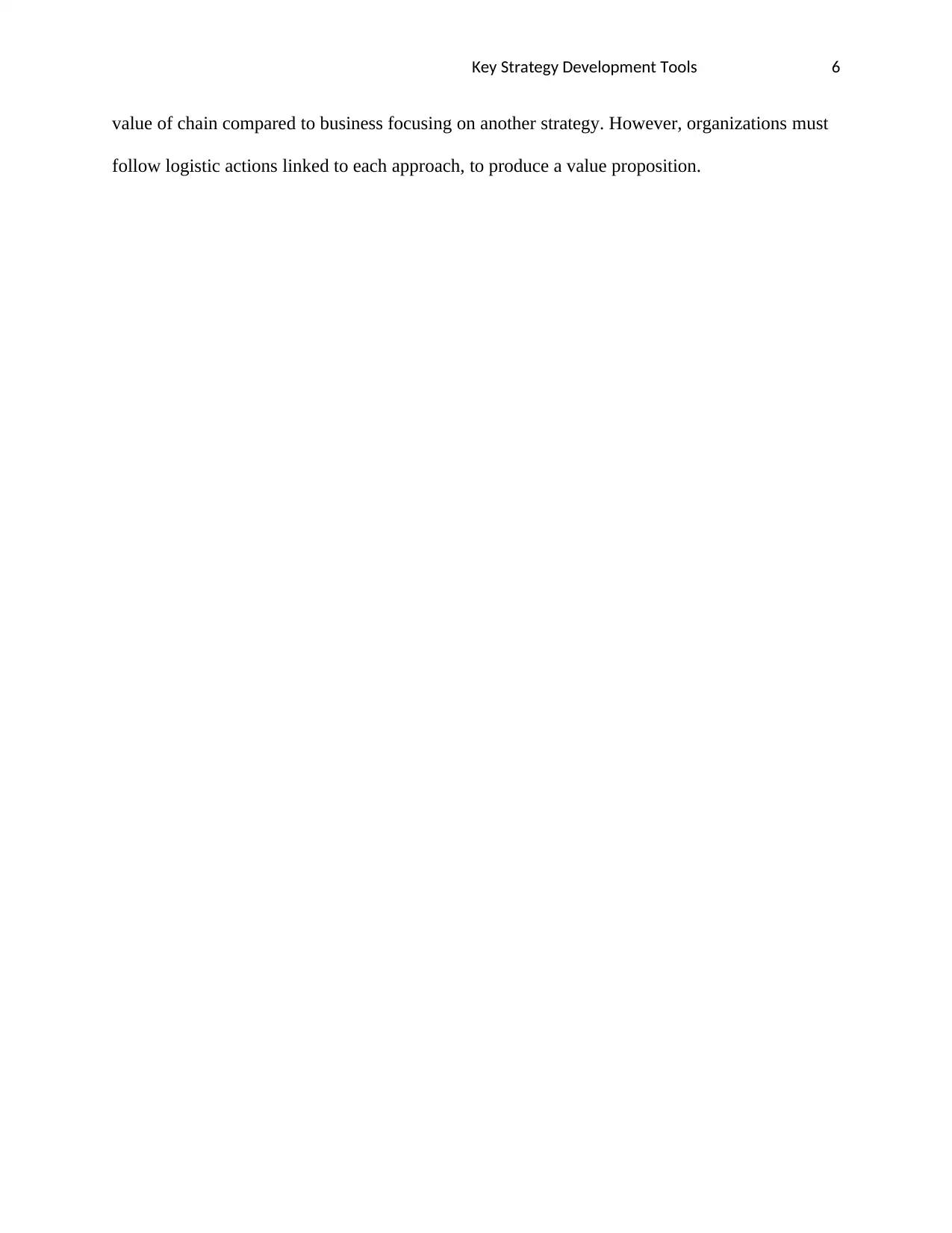
Key Strategy Development Tools 6
value of chain compared to business focusing on another strategy. However, organizations must
follow logistic actions linked to each approach, to produce a value proposition.
value of chain compared to business focusing on another strategy. However, organizations must
follow logistic actions linked to each approach, to produce a value proposition.
⊘ This is a preview!⊘
Do you want full access?
Subscribe today to unlock all pages.

Trusted by 1+ million students worldwide
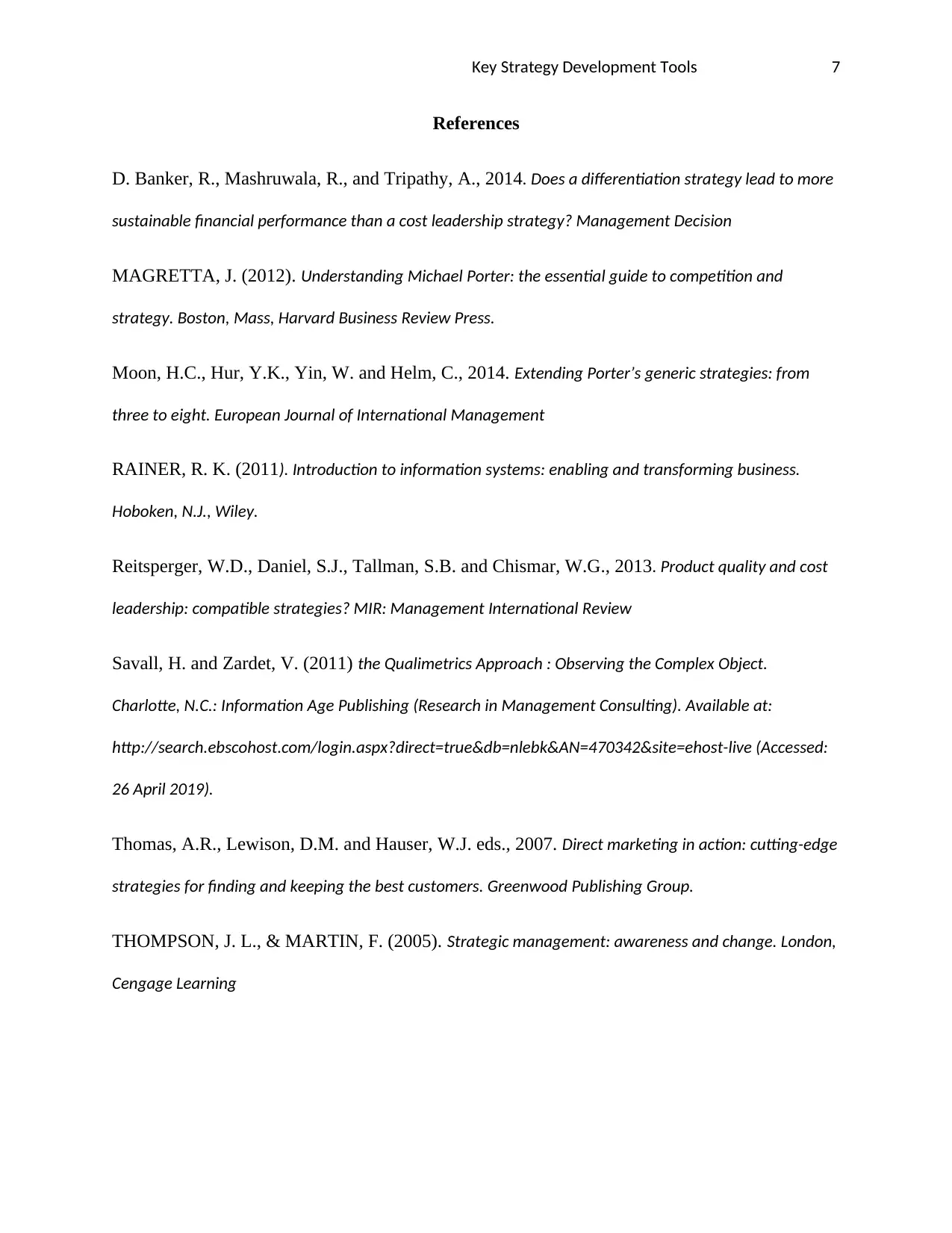
Key Strategy Development Tools 7
References
D. Banker, R., Mashruwala, R., and Tripathy, A., 2014. Does a differentiation strategy lead to more
sustainable financial performance than a cost leadership strategy? Management Decision
MAGRETTA, J. (2012). Understanding Michael Porter: the essential guide to competition and
strategy. Boston, Mass, Harvard Business Review Press.
Moon, H.C., Hur, Y.K., Yin, W. and Helm, C., 2014. Extending Porter’s generic strategies: from
three to eight. European Journal of International Management
RAINER, R. K. (2011). Introduction to information systems: enabling and transforming business.
Hoboken, N.J., Wiley.
Reitsperger, W.D., Daniel, S.J., Tallman, S.B. and Chismar, W.G., 2013. Product quality and cost
leadership: compatible strategies? MIR: Management International Review
Savall, H. and Zardet, V. (2011) the Qualimetrics Approach : Observing the Complex Object.
Charlotte, N.C.: Information Age Publishing (Research in Management Consulting). Available at:
http://search.ebscohost.com/login.aspx?direct=true&db=nlebk&AN=470342&site=ehost-live (Accessed:
26 April 2019).
Thomas, A.R., Lewison, D.M. and Hauser, W.J. eds., 2007. Direct marketing in action: cutting-edge
strategies for finding and keeping the best customers. Greenwood Publishing Group.
THOMPSON, J. L., & MARTIN, F. (2005). Strategic management: awareness and change. London,
Cengage Learning
References
D. Banker, R., Mashruwala, R., and Tripathy, A., 2014. Does a differentiation strategy lead to more
sustainable financial performance than a cost leadership strategy? Management Decision
MAGRETTA, J. (2012). Understanding Michael Porter: the essential guide to competition and
strategy. Boston, Mass, Harvard Business Review Press.
Moon, H.C., Hur, Y.K., Yin, W. and Helm, C., 2014. Extending Porter’s generic strategies: from
three to eight. European Journal of International Management
RAINER, R. K. (2011). Introduction to information systems: enabling and transforming business.
Hoboken, N.J., Wiley.
Reitsperger, W.D., Daniel, S.J., Tallman, S.B. and Chismar, W.G., 2013. Product quality and cost
leadership: compatible strategies? MIR: Management International Review
Savall, H. and Zardet, V. (2011) the Qualimetrics Approach : Observing the Complex Object.
Charlotte, N.C.: Information Age Publishing (Research in Management Consulting). Available at:
http://search.ebscohost.com/login.aspx?direct=true&db=nlebk&AN=470342&site=ehost-live (Accessed:
26 April 2019).
Thomas, A.R., Lewison, D.M. and Hauser, W.J. eds., 2007. Direct marketing in action: cutting-edge
strategies for finding and keeping the best customers. Greenwood Publishing Group.
THOMPSON, J. L., & MARTIN, F. (2005). Strategic management: awareness and change. London,
Cengage Learning
Paraphrase This Document
Need a fresh take? Get an instant paraphrase of this document with our AI Paraphraser
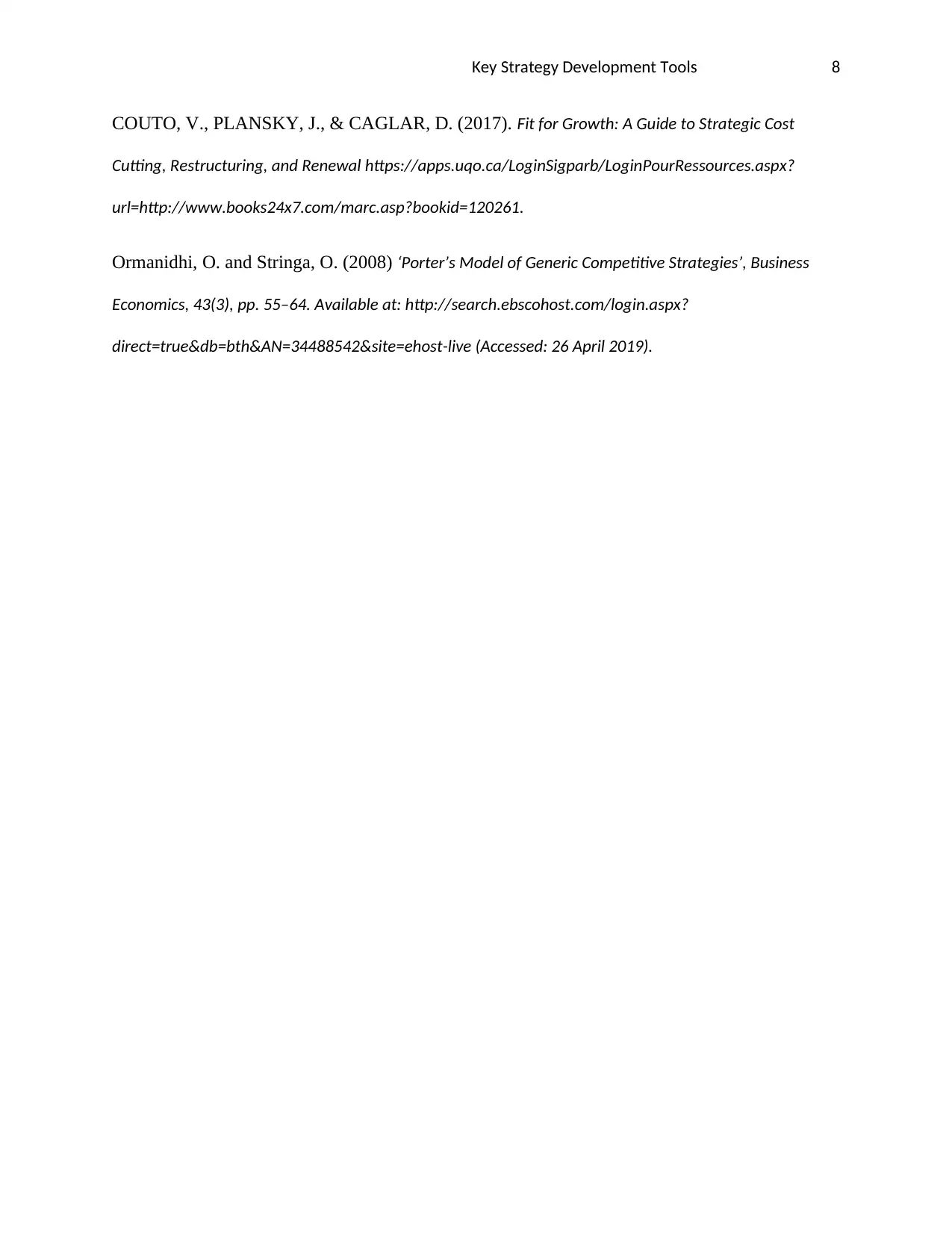
Key Strategy Development Tools 8
COUTO, V., PLANSKY, J., & CAGLAR, D. (2017). Fit for Growth: A Guide to Strategic Cost
Cutting, Restructuring, and Renewal https://apps.uqo.ca/LoginSigparb/LoginPourRessources.aspx?
url=http://www.books24x7.com/marc.asp?bookid=120261.
Ormanidhi, O. and Stringa, O. (2008) ‘Porter’s Model of Generic Competitive Strategies’, Business
Economics, 43(3), pp. 55–64. Available at: http://search.ebscohost.com/login.aspx?
direct=true&db=bth&AN=34488542&site=ehost-live (Accessed: 26 April 2019).
COUTO, V., PLANSKY, J., & CAGLAR, D. (2017). Fit for Growth: A Guide to Strategic Cost
Cutting, Restructuring, and Renewal https://apps.uqo.ca/LoginSigparb/LoginPourRessources.aspx?
url=http://www.books24x7.com/marc.asp?bookid=120261.
Ormanidhi, O. and Stringa, O. (2008) ‘Porter’s Model of Generic Competitive Strategies’, Business
Economics, 43(3), pp. 55–64. Available at: http://search.ebscohost.com/login.aspx?
direct=true&db=bth&AN=34488542&site=ehost-live (Accessed: 26 April 2019).
1 out of 8
Related Documents
Your All-in-One AI-Powered Toolkit for Academic Success.
+13062052269
info@desklib.com
Available 24*7 on WhatsApp / Email
![[object Object]](/_next/static/media/star-bottom.7253800d.svg)
Unlock your academic potential
Copyright © 2020–2025 A2Z Services. All Rights Reserved. Developed and managed by ZUCOL.





